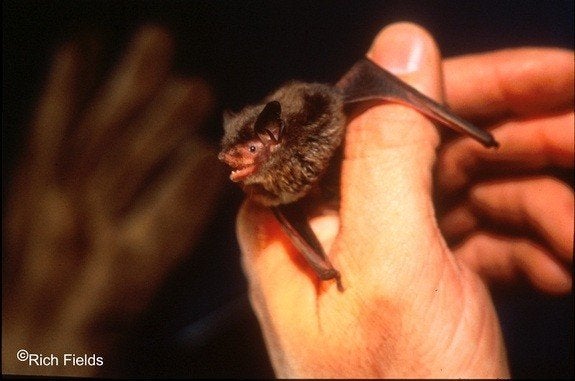
Each the spring, female Indiana bats leave the cool caves where they spend the winter hibernating and head north, gathering together in trees to form maternity colonies to have their young. A new study shows that climate change could squeeze these bat moms into a much smaller range over the next 50 years.
The endangered bats are currently found over most of the eastern half of the United States, but researchers found that much of Missouri, Iowa, Illinois, Kentucky, Indiana and Ohio will become inhospitable for the species' maternity colonies under most climates they modeled.
"We found that due to projected changes in temperature, the most suitable summer range for Indiana bats would decline and become concentrated in the northeastern United States and the Appalachian Mountains," ecologist Susan Loeb, of the U.S. Forest Service's Southern Research Station, said in a statement.
Previous studies have shown that animals worldwide are shifting their habitats to try to outrun climate change. But species like Indiana bats might be more vulnerable than other mammals in the face of global warming, because their reproductive cycles, hibernation patterns and migration are highly dependent on temperature, the researchers said.
"Our model suggests that once average summer (May through August) maximum temperatures reach 27.4 degrees C (81.3 degrees F), the climatic suitability of the area for Indiana bat maternity colonies declines," Loeb said. "Once they reach 29.9 degrees C (85.8 degree F), the area is forecast to become completely unsuitable. Initially, Indiana bat maternity colonies may respond to warming temperatures by choosing roosts that have more shade than the roosts that they currently use. Eventually, it is likely that they will have to find more suitable climates."
The tiny bats, which weigh about the same as three pennies but can have a wingspan up to 11 inches (28 centimeters), were listed as endangered in the United States in 1967. After decades of decline, the bats' population picked up from 2000 to 2005, largely thanks to conservation efforts, but species' numbers plunged again with the spread of the devastating white nose syndrome. Nicknamed for the powderlike fungal growth that appeared on the hibernating bats' snouts, the mysterious bat-killing disease was first documented in New York in 2006 and has since spread to caves across the Northeast. In 2011, the number of Indiana bats reported hibernating in the northeastern United States was down by 72 percent.
According to the new study, maternity colonies in the western portion of the bats' range likely will begin to decline, and possibly vanish, in the next 10 to 20 years, and by 2060, much of the region will be wholly unsuitable for roosting. The grim forecast has important implications for wildlife managers in the Northeast and the Appalachian Mountains, Loeb said, since these areas will likely become refuges for the bats when regions in the Midwest get too warm.
"Management actions that foster high reproductive success and survival will be critical for the conservation and recovery of the species," she said.
The findings were detailed online in January in the journal Ecology and Evolution.
Follow LiveScience on Twitter @livescience. We're also on Facebook & Google+.
Copyright 2013 LiveScience, a TechMediaNetwork company. All rights reserved. This material may not be published, broadcast, rewritten or redistributed.
